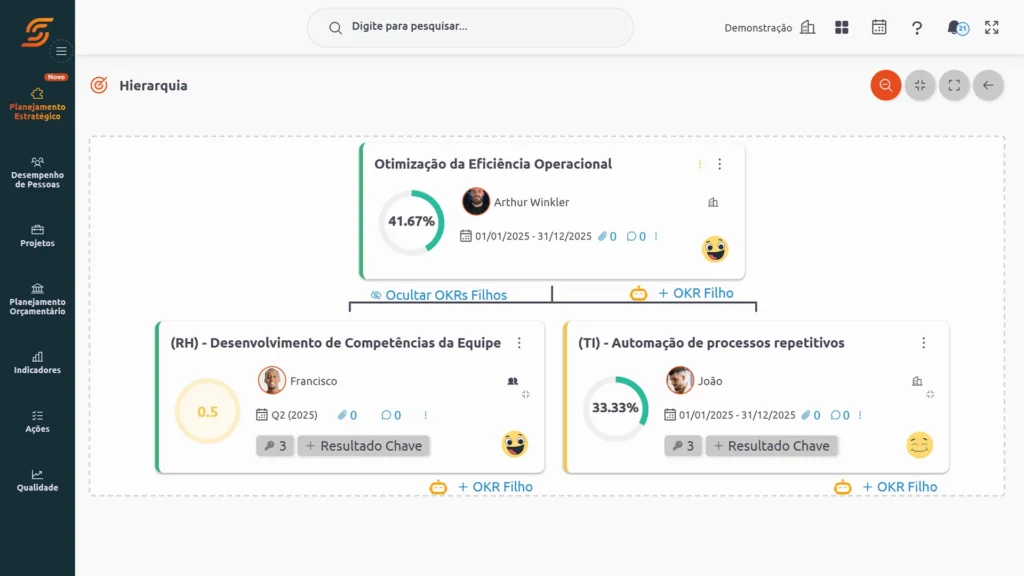Talking about quality management today goes far beyond following protocols, earning certifications, or ticking checklists.
Quality has become a true competitive edge—and in large companies, it must be integrated into strategic planning to avoid rework, recurring failures, and that outdated document chaos no one wants to deal with anymore.
After all, growing consistently requires well-defined processes and smart control.
That’s where quality management software comes in: a tech solution that automates routines, connects departments, speeds up quality audits, and enables real-time tracking of quality indicators.
In this article, you’ll discover how this tool transforms process control into a strategic and collaborative operation.
You’ll also learn how to choose the best solution for your company—and understand what makes Scoreplan stand out.
What is quality management software and why it’s essential today
Think of quality management software as the operational brain that links quality with strategy.
It centralizes everything: documents, indicators, action plans, non-conformities, quality audit records, and more.
Instead of scattered files, endless email chains, and constant rework, you get everything organized, traceable, and accessible in real time. That means:
- More standardization
- Fewer human errors
- Scalable processes
- And a quality automation fully aligned with your company’s strategic goals
With a robust quality management system, companies stop “putting out fires” and start preventing failures, making data-driven decisions, and achieving real improvements.
How the software organizes and automates processes securely
One of the biggest pain points in quality management is document disorganization.
The classic scenario: each department stores its own version of a procedure in a different folder, and no one knows which is the official or most up-to-date document.
This lack of standardization not only delays workflows, but also opens the door to mistakes, rework, and non-conformities.
Worse yet: in a quality audit, something as simple as a missing document can jeopardize the entire certification process.
That’s when quality management software turns the game around.
It centralizes and organizes all documents, records, and workflows in a single platform—with full data security and traceability.
Each file has a revision history, access control, and customizable permissions. You define who can view, edit, or approve each step, ensuring compliance with standards like ISO 9001.
And more: with automated workflows, the system notifies the right people at the right time, triggers approvals and updates automatically, and keeps everything on track with deadlines and protocols.
This means less noise between teams, faster operations, and a quality management process that’s both secure and efficient.
Quality indicators: real-time monitoring and control
If data is the new oil, then quality indicators are the compass. A good quality management software turns numbers into insights through intuitive dashboards, interactive charts, and real-time alerts.
You set the KPIs, and the system automatically collects, updates, and displays the data. The result? Less time on spreadsheets, more time thinking strategically.
Even better: quality indicators can be integrated with HR, planning, and finance departments. After all, ensuring a quality product or service directly impacts your budget, reputation, and strategic goals.
???? Learn more: Principles of Quality Management
Faster and more effective audits and corrective actions
Say goodbye to audit-day surprises. With quality management software, internal audit processes are automated with evidence trails, linked action plans, and full traceability.
Non-conformities are recorded in the system with assigned owners, deadlines, and status updates.
Corrective actions are visible to everyone involved, which speeds up resolution cycles and ensures that nothing gets forgotten—or worse, lost in an Excel file.
With this, audits shift from being a burden to becoming a natural part of your continuous improvement process.
Integrated collaboration: when quality becomes everyone’s job
Forget the outdated idea that quality is “just QHSE’s job.” Quality belongs to everyone — and good software makes that clear in practice.
With personalized profiles, automatic notifications, and cross-department approval flows, the system promotes collaboration between teams like Projects, HR, Planning, and Operations.
Everyone participates. Everyone contributes.
The result? Real engagement, smooth communication, and faster execution of quality processes.
Even that one manager who used to say “this isn’t my job” will start checking the dashboard.
How to choose the best quality management software for your company

When choosing a quality management software, don’t just go for the most well-known brand.
The best choice is the one that truly fits your company’s needs and daily routines.
To get it right, evaluate a few strategic criteria that go far beyond simply “organizing documents”:
| Criteria | What to Look For | Why It Matters |
|---|---|---|
| System Integration | Compatibility with ERP, BI, HR, CRM, etc. | Enables connected management and avoids manual rework. |
| Usability | Intuitive interface, ease of use, learning curve | Promotes adoption by teams and saves time. |
| Flexibility | Customizable workflows, permissions, naming | Allows the system to reflect your actual business operations. |
| Cost-Benefit Ratio | Fair price for features and expected outcomes | Ensures ROI without unexpected costs. |
| Information Security | Access levels, encryption, backups, legal compliance | Protects sensitive data and ensures compliance with standards. |
Tip: Involve multiple departments in the selection process, test the software in real scenarios, and don’t be afraid to ask tough questions.
The right system should be a long-term partner—a true strategic ally.
The Scoreplan advantage: connecting quality to strategy and results
Scoreplan goes beyond standard quality systems.
It connects quality with strategic planning, corporate goals, and performance indicators—all in a single platform.
You manage processes, indicators, audits, and action plans fully aligned with organizational objectives.
In other words, quality stops being a silo and becomes an active part of your business strategy.
???? Click here to book a free demo and see it in action.
Conclusion
Quality can’t just be a pretty theory in the company manual. It must live in the day-to-day, in the processes, in decisions—and most importantly, in the results.
With the support of technology, it’s possible to turn this ideal into reality with agility, security, and intelligence.
Quality management software is more than a tool—it’s a strategic ally for companies that want to grow with consistency.
Ready to take the next step?
???? Book a free demo and discover how Scoreplan can transform quality management in your business.




